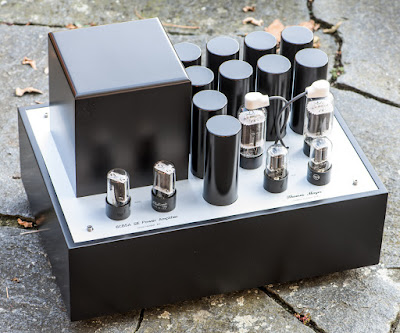After all the recent amplifier builds with expensive triodes and multiple chassis, it has been a welcome change to build a single chassis stereo power amp based on the 6CB5A tube again.
I have built many versions of amplifiers with this output tube, from a RC coupled low cost version to some ultimate versions with the best possible transformers and separate power supplies. This one is in the middle. It's single chassis stereo, interstage transformer coupled with Lundahl transformers.
I have written before that I consider such an amp as a smart choice when the budget is limited. With tube amplifiers people have always been way to focussed just on the output tube alone. It is very common that the sound of an amp is attributed to the tube. This is simply wrong. I have written before that the output tube contributes maybe 10-15% to the overall sound of an amp. Nothing can be said about the sound of an amp if only the tube is known.
Yet I am getting increasing questions about the sound of tubes. It's is probably partly my own fault because of my rants about certain directly heated triodes and especially the Elrog 300B which in my experience still holds the title for best sounding output tube. But this sound quality can only be obtained if all other aspects of the amp allow for it.
If the budget does not allow to match such directly heated triodes with very good transformers, an excellent power supply, including elaborate filaments supplies, much better overall sound can be achieved with other tubes, like the 6CB5A triode wired.
The cost of the tubes is very low and frees up budget to use better output transformers and other parts. The 6CB5A is indirectly heated and does not require a special filament supply. It is happy with a simple AC winding on the power transformer and can be operated hum free like that. Combined with a suitable driver tube, in this case the 6N7 which is my preferred choice for the 6CB5A, it is an excellent performer.
In this particular version a pair of input transformers has been added to allow balanced connection to the preamp.
I am always happy if someone does not insist on a 300B, but is open for such a smart choice like this one.
Best regards
Thomas




























































































